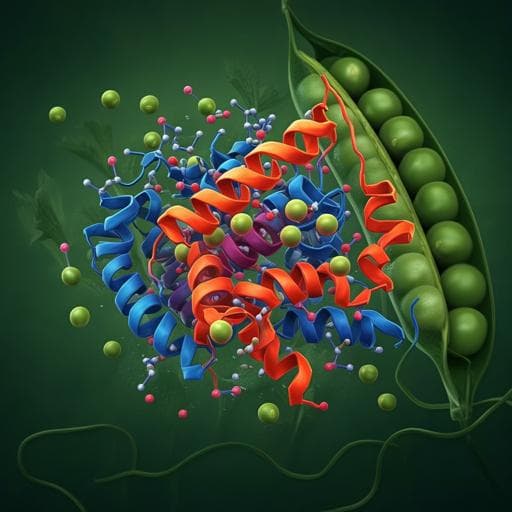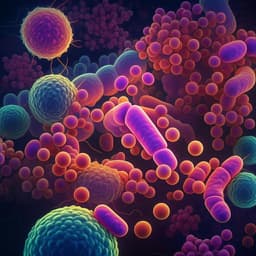
Food Science and Technology
Comparative effects of high pressure processing and heat treatment on in vitro digestibility of pea protein and starch
A. E. Hall and C. I. Moraru
Discover how high-pressure processing (HPP) and heat treatment impact the digestibility of protein in pea protein concentrate (PPC), as revealed by the research conducted by Alexandra E. Hall and Carmen I. Moraru. HPP enhances gastric proteolysis without changing overall digestibility. Dive into the findings that challenge traditional views on plant-based protein processing!
~3 min • Beginner • English
Introduction
High-pressure processing (HPP) is a nonthermal technology that alters noncovalent interactions in food biopolymers and can modify protein and starch structures without the sensory and nutritional drawbacks of heat. Pulse proteins (e.g., pea) are of growing interest but have lower protein quality due to amino acid limitations, protein conformations limiting protease access, and antinutritional factors such as trypsin inhibitors. Prior studies on HPP effects on plant protein digestibility show mixed results and often use low protein concentrations or incomplete enzyme systems. Starch present in pea protein concentrates may respond differently to pressure versus heat, with potential implications for resistant starch and health. This study aimed to determine how HPP versus heat affect in vitro digestibility of proteins and starch and trypsin inhibitor activity in pea protein concentrate at two protein concentrations (5% and 15%), using both standardized static and dynamic gastrointestinal models.
Literature Review
The authors note that HPP (200–600 MPa) stabilizes hydrogen bonds and disrupts hydrophobic/electrostatic interactions, leading to structural modification of food polymers. Previous work showed HPP-induced structural changes in pea and milk proteins and the potential to tailor textures. Plant protein digestibility can improve or decline depending on denaturation and aggregation; thermal treatments may inactivate trypsin inhibitors but can also promote aggregation that hinders digestion. Studies on HPP effects on legume proteins have reported variable digestibility outcomes, often limited by test conditions (low protein levels, incomplete enzyme panels). For starch, heat generally increases digestibility via gelatinization, while HPP can preserve granule structure, with mixed effects on digestibility reported. These prior findings motivated a controlled comparison of HPP and heat under food-relevant protein concentrations and comprehensive digestion assays.
Methodology
Materials: Commercial pea protein concentrate (PPC; 54.5% protein, 4.3% starch d.w.) was used to prepare two matrices: 5% (w/w) protein (5P; ~0.40% starch) and 15% (w/w) protein (15P; ~1.19% starch). Samples were high-shear mixed, vacuum-packed, held 24 h at 4 °C, then treated.
Treatments: HPP at 600 MPa, 5 °C, 4 min (55 L Hiperbaric). Heat at 95 °C for 15 min (water bath), then cooled on ice. Treated samples stored at 4 °C and digested within 24 h.
In vitro digestion models: Two models were used.
- Static digestion followed the COST INFOGEST protocol with minor modifications at 37 °C: oral (2 min; α-amylase for 15P only), gastric (2 h, pH 3, pepsin 2000 U/mL), intestinal (2 h, pH 7, pancreatin 100 U/mL trypsin basis + bile). Separate replicate digestions were used to collect cumulative gastric (SG) and cumulative intestinal (SI) digesta. Digesta were snap-frozen (−80 °C for SG; −80 °C post Pefabloc addition for SI).
- Dynamic digestion used the TIM-1 system (stomach, duodenum, jejunum, ileum) over 240 min at 37 °C. One hundred grams of feed (5P or 15P) was introduced with enzyme/electrolyte solutions. Secretions and pH were computer-controlled. Jejunal and ileal dialysates were collected at 20–240 min (nine time points), pooled by compartment, weighed, and frozen.
Pre-analytical processing: Static SG and SI were serially ultrafiltered (50, 30, 10 kDa cutoffs) to yield <10 kDa permeates for BCA, OPA, and glucose assays. Dynamic digesta were analyzed without ultrafiltration for assays as specified.
Assays:
- SDS-PAGE: Unfiltered static SG and SI plus undigested PPC were analyzed on 12% bis-tris gels; bands quantified to compute relative protein concentration vs untreated.
- Protein digestibility: BCA assay quantified peptides roughly ≥ tripeptides to <10 kDa. Results expressed as relative protein digestibility (RPDBCA) vs untreated controls (static: vs SUntreated; dynamic: vs DCT240,Untreated).
- Small peptides/free amino acids: OPA assay measured peptides <6 kDa and free amino acids in static SG and SI; expressed as RPDOPA vs SUntreated.
- Starch digestibility (15P only): Glucose (HK) assay quantified glucose released in static SI and dynamic jejunal/ileal dialysates. Relative starch digestibility (RSD) computed vs SUntreated (static) or DCT240,Untreated (dynamic). Dynamic starch fractions were categorized as rapidly digestible (0–20 min), slowly digestible (20–120 min), and resistant (>120 min) per Englyst.
- Trypsin inhibitor activity (5P only): Extracted inhibitors were assayed with BAPNA substrate using porcine trypsin; activity expressed as mg trypsin inhibited/g protein and as relative activity vs untreated.
Statistics: Three independent replicates per treatment and concentration for each digestion model. Static assays in technical triplicate (SDS-PAGE duplicate); dynamic assays in technical duplicate. Linear mixed models in R (lmerTest, emmeans), with fixed effects for treatment (and time, plus interaction for dynamic), random effects for replicate (and treatment within replicate for dynamic). Dynamic data were log-transformed. Tukey’s multiple comparisons at α=0.05.
Key Findings
- Matrix formation: After treatment, 5P remained solutions; 15P formed self-standing gels (HPP gel predominantly noncovalent; heat gel enriched in disulfide bonds per prior work).
- Static gastric protein hydrolysis (SDS-PAGE): HPP-treated SG showed lowest relative dye-binding protein concentration, indicating greater proteolysis and altered peptide patterns versus untreated and heat-treated.
• 5P SG relative protein concentration: HPP 0.59 ± 0.06; heat 0.90 ± 0.12; untreated 1.00 ± 0.07. Differences significant between untreated vs HPP and HPP vs heat (p < 0.05).
• 15P SG: HPP showed lower values than heat; HPP vs heat significant (p < 0.05); HPP vs untreated not significant.
• SI digesta: bands mainly digestive enzymes; no significant treatment differences in relative protein concentration for 5P or 15P (p > 0.05).
- Static peptide release (BCA and OPA): At end of gastric phase, RPDBCA and RPDOPA followed HPP-treated > untreated > heat-treated for both concentrations; HPP > (untreated and heat) significant (p < 0.05). For 15P, untreated > heat in RPDBCA at gastric end (p < 0.05). After intestinal phase, overall RPDBCA and most RPDOPA differences were not significant; only HPP > heat for 15P in RPDOPA at SI (p < 0.05).
- Dynamic digestion (BCA): Cumulative jejunal and total RPDBCA trends: for 5P, HPP > heat > untreated; for 15P, untreated > HPP > heat. Heat-treated generally lower after ileal digestion but differences mostly not significant. Significant differences were confined to early time points: first 20 min for 5P (jejunal, ileal, total) and first 60 min for 15P (ileal). Thereafter, no significant differences among treatments.
- Trypsin inhibitor activity (5P): Heat treatment reduced relative activity to 0.31 ± 0.03 (~70% reduction) vs untreated 1.00 ± 0.05 and HPP 1.01 ± 0.05; heat vs others significant (p < 0.05). HPP did not reduce activity.
- Starch digestibility (15P): Static SI RSD: untreated 1.00 ± 0.04; HPP 1.01 ± 0.01; heat 0.99 ± 0.02 (no significant differences). Dynamic jejunal, ileal, and total RSD showed sigmoidal kinetics with trends heat ≥ HPP ≥ untreated (jejunum/total) and HPP ≥ heat ≥ untreated (ileum), but no significant differences at any time point. Starch fractionation showed untreated had highest resistant starch and lowest rapidly/slowly digestible fractions; heat-treated the inverse; HPP intermediate; differences not significant.
Discussion
HPP and heat both denature and aggregate pea proteins but form distinct structures: HPP induces aggregates held predominantly by weaker noncovalent interactions, whereas heat promotes covalent disulfide cross-linking. Consequently, HPP-treated matrices exhibited greater initial accessibility to proteolytic enzymes, particularly pepsin, enhancing early-stage gastric proteolysis and altering peptide profiles. Despite these initial differences, overall in vitro protein digestibility after complete intestinal phases (static and dynamic) did not differ significantly among treatments, indicating that structural effects primarily influence early cleavage accessibility rather than final digestibility extent. Heat treatment substantially inactivated trypsin inhibitors, but this did not translate into superior protein digestibility, likely because heat-induced aggregation limited enzyme access more than inhibitor inactivation aided digestion. Protein concentration modulated effects: at 15% protein, gel network formation and crowding likely reduced accessibility and influenced early ileal kinetics differently than at 5% protein. For starch, under the low starch content of PPC and high amylase:substrate ratios, pressure- or heat-induced granule changes did not significantly affect digestibility, though dynamic trends aligned with literature (heat ≥ HPP ≥ untreated). Differences between static and dynamic models (sampling phases, enzyme activities, shear, and kinetics) preclude direct comparison of absolute values, but both models consistently show enhanced initial proteolysis with HPP and no change in overall digestibility.
Conclusion
HPP at 600 MPa for 4 min and heat at 95 °C for 15 min modify pea protein structures differently. HPP enhanced initial gastric proteolysis and altered peptide profiles relative to untreated and heat-treated PPC, but neither HPP nor heat changed overall in vitro protein or starch digestibility by the end of digestion. Heat reduced trypsin inhibitor activity by ~70%, whereas HPP did not. These findings indicate HPP can be used to create desirable textures in pea protein systems without compromising overall protein or starch digestibility, while potentially improving early proteolysis. Future work should investigate physiological implications of accelerated early proteolysis (e.g., postprandial amino acid availability), explore a broader range of HPP/thermal conditions and matrices, assess in vivo relevance, and evaluate higher starch systems for pressure effects on starch digestibility.
Limitations
- In vitro models: Results may not fully translate to in vivo digestion; static and dynamic models differ in sampling phases, enzyme ratios/activities, and hydrodynamics, limiting direct comparisons.
- Limited treatment conditions: Single HPP setting (600 MPa, 5 °C, 4 min) and single heat condition (95 °C, 15 min) were tested.
- Composition constraints: Starch analyses were limited to 15P due to low starch in 5P; trypsin inhibitor activity was measured only in 5P.
- Static sampling only at phase endpoints (no time-course), potentially missing transient kinetics.
- PPC is a complex matrix; results may differ for isolates, other legumes, or formulated foods with additional components.
Related Publications
Explore these studies to deepen your understanding of the subject.







